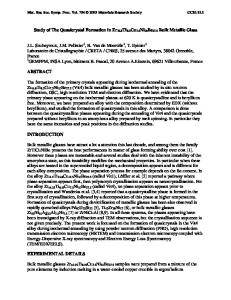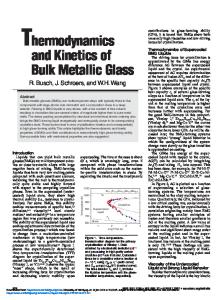Quasicrystal Formation in a Zr-based Bulk Metallic Glass
- PDF / 3,027,136 Bytes
- 6 Pages / 612 x 792 pts (letter) Page_size
- 26 Downloads / 328 Views
MM4.8.1/LL6.8.1
Quasicrystal Formation in a Zr-based Bulk Metallic Glass L. Liu1,2, K.C. Chan1, G. K.H. Pang3, 1 Department of Industrial & Systems Engineering, The Hong Kong Polytechnic University, Hong Kong 2 3
The State Key Lab of Die & Mould Technology, Huazhong University of Science and Technology, China Department of Applied Physics, The Hong Kong Polytechnic University, Hong Kong
ABSTRACT Zr65Ni10Cu7.5Al7.5Ag10 bulk metallic glass with a diameter of 2 mm and a length of 50 mm was prepared by copper-mould casting. The metallic glass obtained follows two-step crystallization reactions with the initial formation of metastable quasicrystals from amorphous phase, followed by the formation of a stable intermetallic Zr2Cu from the post-formed quasicrystals. In this paper, the microprocess of the amorphous-to-quasicrystalline transformation of Zr65Ni10Cu7.5Al7.5Ag10 bulk metallic glass was studied in detail by TEM and high resolution TEM coupled with nanobeam EDX. It was found that the amorphous-to-quasicrystalline transformation in the present system does not follow the traditional nucleation/growth mechanism. Instead, it undergoes a series of inter-processes and follows the sequence of phase transformation of amorphous→FCC Zr2Ni →Tetragonal Zr2Ni → Quasicrystals. Nanobeam EDX revealed that atomic diffusion was involved in all inter-processes of the phase transformations, suggesting that the amorphous-to-quasicrystalline transformation in the present bulk metallic glass is a non-polymorphous reaction. INTRODUCTION Recently, it has been reported that an icosahedral quasicrystalline phase could precipitate from amorphous phase upon annealing in a few Zr-based metallic glasses with high glass forming ability, such as Zr-Al-Cu, Zr-Ni-Al-Cu [1] and Zr-Al-Cu-Ni-Ti [2]. The amorphous-to-quasicrystalline transformation in these systems usually occurred at the initial stage of crystallization and the quasicrystal formation is very sensitive to the oxygen content and cooling rate in the sample preparation [2-4]. However, the quasicrystalline forming ability of the Zr-based alloys could be highly enhanced by the addition of noble metals or refractory metals [5-10]. Concerning the mechanism for the transformation, most researchers believed that the amorphous-to-quasicrystalline transformation in Zr-based systems follows the traditional nucleation/growth mechanism, and it is assumed that the quasicrystalline short-range ordering clusters have already existed in the glassy state [9, 10]. There are also conflicting views on the role of atomic diffusion in the transformation. Some considered that the transformation is polymorphous, i.e., atomic diffusion is not involved, while others argued that it is non-polymorphous, i.e., atomic diffusion is involved [8, 11]. Zr65Ni10Cu7.5Al7.5Ag10 is one noble-metal containing system, which is developed from its precursor, Zr65Ni10Cu17.5Al7.5, with part of Cu being substituted by Ag. This modified alloy also exhibits high glass forming ability and can be easily cast into bulk metallic glass
Data Loading...











